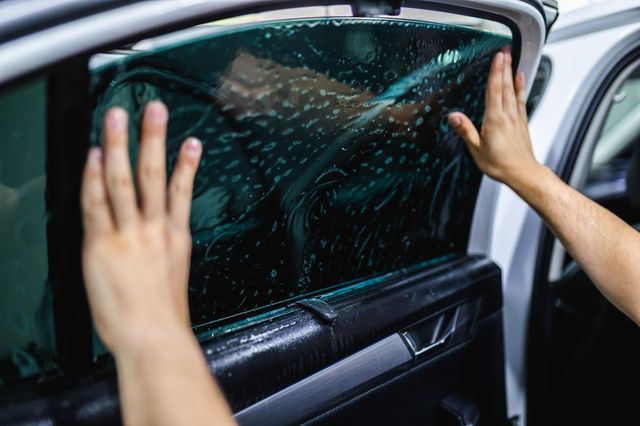Auto Window Tinting: Durable Security for Your Automobile's Windows
Wiki Article
Home Window Tinting Laws and Guidelines: What You Required to Know Prior To Tinting Your Cars And Truck
Before proceeding with window tinting for your automobile, it is essential to familiarize on your own with the varied legislations and guidelines that govern this practice across various states. These regulations determine the permitted levels of color darkness, frequently measured by visible light transmission (VLT) percents, and consist of details specifications for front windshields aimed at making sure roadway safety and security.Introduction of Home Window Tinting Rules
Window tinting legislations are often based on variation throughout various territories, showing local laws and safety considerations. These legislations determine the acceptable degrees of tint darkness and reflectiveness on automobile home windows, guaranteeing that motorists preserve ample exposure while also shielding against damaging UV rays and warm.Many regulations categorize home window tinting based upon the Visible Light Transmission (VLT) percentage, which shows the quantity of light that can go through the home window. Normally, reduced VLT portions indicate darker colors. Laws commonly distinguish in between the front, side, and rear home windows, with stricter restrictions put on the front windshield to improve safety and security for both the driver and other roadway individuals.
Compliance with window tinting guidelines is essential, as infractions can result in fines, required elimination of the tint, and possible boosts in insurance costs. It is necessary for automobile proprietors to familiarize themselves with regional laws before proceeding with home window tinting installations.
State-by-State Color Laws
Comprehending the details window tinting regulations in each state is vital for lorry proprietors looking for to follow the legislation. Each state in the U.S. has established its own set of policies governing home window tinting, which can differ substantially. These regulations usually dictate the allowable degrees of tint darkness, the sorts of home windows that can be tinted, and any medical exemptions that might use.As an example, states like California have rigid limitations on color darkness for front windows, while others, such as New Mexico, may permit darker tints. Additionally, specific states mandate particular presence percents for various home windows, including the windscreen, front side home windows, and rear windows. It is vital for auto owners to familiarize themselves with their state's legislations to avoid possible fines or charges.
Furthermore, some states may require a qualification sticker label to be positioned on tinted windows, indicating compliance with state legislations. Failing to stick to these regulations not only risks legal repercussions yet can also affect safety and security and visibility while driving. For that reason, automobile proprietors need to carry out detailed research study or get in touch with neighborhood authorities to ensure full understanding and compliance with state-by-state color guidelines.
Allowed Tint Degrees and Kinds
Lots of vehicle proprietors may be surprised to learn that permitted color levels and kinds differ widely throughout different states. Each state has actually established its own laws pertaining to the acceptable darkness and reflectivity of window tint, typically gauged by Visible Light Transmission (VLT) percentages. VLT refers to the quantity of light that can travel through the tinted home windows; therefore, a lower percentage shows a darker tint.
Furthermore, the sorts of tint materials allowed can vary, with some states forbiding mirror-like or metal coatings. It is necessary for car proprietors to acquaint themselves with their state's certain laws to guarantee conformity. Non-compliance can result in penalties, required removal of the color, or other legal repercussions, making it crucial to understand these laws prior to waging installment.
Medical Exceptions for Tinting
While not all states supply allowances for clinical exceptions concerning window tinting, those that do identify the necessity for particular individuals to boost exposure and comfort because of clinical conditions. Different medical problems, such as lupus, skin cancer cells, and certain eye disorders, can render people particularly sensitive to sunlight. These individuals may require darker tints to secure themselves from harmful UV rays and glare.
It is important to keep in mind that despite a medical exception, there might still be limitations on the degree of tint allowed. Compliance with state legislations ensures that people are both safeguarded and within legal limitations. Those taking into consideration medical exceptions must call their local Division of Electric motor Vehicles or comparable authority to here are the findings comprehend the demands and procedures needed to request an exception effectively.
Penalties for Non-Compliance
Stopping working to adhere to home window tinting regulations can result in substantial penalties, which differ by state. Law enforcement companies are empowered to provide citations for vehicles that do not follow the defined tinting laws. These charges normally include fines, which can range from modest amounts to several hundred bucks, depending upon the seriousness of the violation and the state concerned.In some jurisdictions, duplicated offenses might cause intensifying penalties or added penalties, such as obligatory court looks. Additionally, non-compliance might require the removal of unlawful tinting, often at the proprietor's expense. In extreme situations, habitual culprits might deal with suspension of their automobile enrollment until conformity is achieved.
Additionally, insurance ramifications may emerge from obtaining numerous citations for home window color offenses. Insurance companies might watch such infractions as an indication of riskier actions, possibly leading to boosted premiums or difficulty in insurance coverage.
To avoid these fines, it is important for automobile owners to acquaint themselves with their regional window tinting laws and guarantee that their car complies (Window Tinting). This aggressive strategy not only prevents legal ramifications yet likewise promotes road security
Final Thought

Most policies categorize window tinting based on the Visible Light Transmission (VLT) portion, which indicates the quantity of light that can pass with the home window. Conformity with window tinting policies is crucial, as infractions can result in fines, obligatory removal of the tint, and prospective boosts in insurance coverage costs.Understanding the certain window tinting policies in each state is vital for automobile proprietors looking for to conform with the regulation. These guidelines commonly dictate the permitted degrees of tint darkness, the types of home windows that can be tinted, and any kind of medical exemptions click to investigate that might use.
For circumstances, states like California have rigid constraints on tint darkness for front i thought about this home windows, while others, such as New Mexico, might permit darker colors.
Report this wiki page